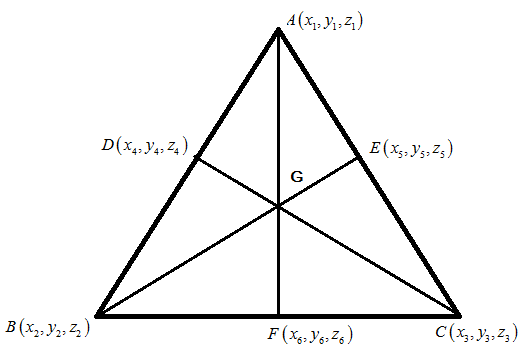
Find the centroid of a triangle, mid-points of whose sides are\[\left( {1,2,3} \right)\], \[\left( {3,0,1} \right)\]and\[\left( { - 1,1, - 4} \right)\].
A.\[\left( { - 1, - 1, - 2} \right)\]
B.\[\left( { - 1,2, - 2} \right)\]
C.\[\left( { - 1,1, - 2} \right)\]
D.\[\left( {1,1, - 2} \right)\]
Answer
572.7k+ views
Hint: The centroid of a triangle is the intersection of the medians of the triangle; it is basically the geometric center of a plane figure. It is always located at the interior of the triangles.
Here, in the question we need to determine the centroid of the triangle whose vertices are given. Add the value of each axis of the three vertices and divide them with three and repeat this for the other two axes to find the centroid. To find the median of a side, add the vertices of each axis of that line segment and divide them by 2 and repeat this for the other axis.
Complete step by step solution:
Let the centroid of the triangle be G
Given the vertices of the triangle
\[A\left( {{x_1},{y_1},{z_1}} \right) \to \left( {1,2, - 3} \right)\]
\[B\left( {{x_2},{y_2},{z_2}} \right) \to \left( {3,0,1} \right)\]
\[C\left( {{x_3},{y_3},{z_3}} \right) \to \left( { - 1,1, - 4} \right)\]

Let the midpoint of the sides of the triangle be D, E, F, hence the midpoint of the triangle will be,
For side AB
\[D\left( {{x_4},{y_4},{z_4}} \right) = \left( {\dfrac{{{x_1} + {x_2}}}{2},\dfrac{{{y_1} + {y_2}}}{2},\dfrac{{{z_1} + {z_2}}}{2}} \right)\]
For side AC
\[E\left( {{x_5},{y_5},{z_5}} \right) = \left( {\dfrac{{{x_1} + {x_3}}}{2},\dfrac{{{y_1} + {y_3}}}{2},\dfrac{{{z_1} + {z_3}}}{2}} \right)\]
For side AC
\[F\left( {{x_6},{y_6},{z_6}} \right) = \left( {\dfrac{{{x_2} + {x_3}}}{2},\dfrac{{{y_2} + {y_3}}}{2},\dfrac{{{z_2} + {z_3}}}{2}} \right)\]
We know the centroid of a triangle is given by the formula
\[G = \left( {\dfrac{{{x_1} + {x_2} + {x_3}}}{3},\dfrac{{{y_1} + {y_2} + {y_3}}}{3},\dfrac{{{z_1} + {z_2} + {z_3}}}{3}} \right)\]
Where the given coordinates are
\[A\left( {{x_1},{y_1},{z_1}} \right) \to \left( {1,2, - 3} \right)\]
\[B\left( {{x_2},{y_2},{z_2}} \right) \to \left( {3,0,1} \right)\]
\[C\left( {{x_3},{y_3},{z_3}} \right) \to \left( { - 1,1, - 4} \right)\]
Hence we can calculate the centroid
\[
G = \left( {\dfrac{{{x_1} + {x_2} + {x_3}}}{3},\dfrac{{{y_1} + {y_2} + {y_3}}}{3},\dfrac{{{z_1} + {z_2} + {z_3}}}{3}} \right) \\
= \left( {\dfrac{{1 + 3 - 1}}{3},\dfrac{{2 + 0 + 1}}{3},\dfrac{{ - 3 + 1 - 4}}{3}} \right) \\
= \left( {\dfrac{3}{3},\dfrac{3}{3},\dfrac{{ - 6}}{3}} \right) \\
= \left( {1,1, - 2} \right) \\
\]
Hence the centroid of the triangle is \[G = \left( {1,1, - 2} \right)\]
Option (D) is correct.
Note: The midpoint is the middle point of a line segment, and it is equidistant from both ends of a line segment. Students should be careful while selecting the coordinates for the centroid. Only the respective coordinates should be taken for the corresponding centroid axes.
Here, in the question we need to determine the centroid of the triangle whose vertices are given. Add the value of each axis of the three vertices and divide them with three and repeat this for the other two axes to find the centroid. To find the median of a side, add the vertices of each axis of that line segment and divide them by 2 and repeat this for the other axis.
Complete step by step solution:
Let the centroid of the triangle be G
Given the vertices of the triangle
\[A\left( {{x_1},{y_1},{z_1}} \right) \to \left( {1,2, - 3} \right)\]
\[B\left( {{x_2},{y_2},{z_2}} \right) \to \left( {3,0,1} \right)\]
\[C\left( {{x_3},{y_3},{z_3}} \right) \to \left( { - 1,1, - 4} \right)\]

Let the midpoint of the sides of the triangle be D, E, F, hence the midpoint of the triangle will be,
For side AB
\[D\left( {{x_4},{y_4},{z_4}} \right) = \left( {\dfrac{{{x_1} + {x_2}}}{2},\dfrac{{{y_1} + {y_2}}}{2},\dfrac{{{z_1} + {z_2}}}{2}} \right)\]
For side AC
\[E\left( {{x_5},{y_5},{z_5}} \right) = \left( {\dfrac{{{x_1} + {x_3}}}{2},\dfrac{{{y_1} + {y_3}}}{2},\dfrac{{{z_1} + {z_3}}}{2}} \right)\]
For side AC
\[F\left( {{x_6},{y_6},{z_6}} \right) = \left( {\dfrac{{{x_2} + {x_3}}}{2},\dfrac{{{y_2} + {y_3}}}{2},\dfrac{{{z_2} + {z_3}}}{2}} \right)\]
We know the centroid of a triangle is given by the formula
\[G = \left( {\dfrac{{{x_1} + {x_2} + {x_3}}}{3},\dfrac{{{y_1} + {y_2} + {y_3}}}{3},\dfrac{{{z_1} + {z_2} + {z_3}}}{3}} \right)\]
Where the given coordinates are
\[A\left( {{x_1},{y_1},{z_1}} \right) \to \left( {1,2, - 3} \right)\]
\[B\left( {{x_2},{y_2},{z_2}} \right) \to \left( {3,0,1} \right)\]
\[C\left( {{x_3},{y_3},{z_3}} \right) \to \left( { - 1,1, - 4} \right)\]
Hence we can calculate the centroid
\[
G = \left( {\dfrac{{{x_1} + {x_2} + {x_3}}}{3},\dfrac{{{y_1} + {y_2} + {y_3}}}{3},\dfrac{{{z_1} + {z_2} + {z_3}}}{3}} \right) \\
= \left( {\dfrac{{1 + 3 - 1}}{3},\dfrac{{2 + 0 + 1}}{3},\dfrac{{ - 3 + 1 - 4}}{3}} \right) \\
= \left( {\dfrac{3}{3},\dfrac{3}{3},\dfrac{{ - 6}}{3}} \right) \\
= \left( {1,1, - 2} \right) \\
\]
Hence the centroid of the triangle is \[G = \left( {1,1, - 2} \right)\]
Option (D) is correct.
Note: The midpoint is the middle point of a line segment, and it is equidistant from both ends of a line segment. Students should be careful while selecting the coordinates for the centroid. Only the respective coordinates should be taken for the corresponding centroid axes.
Recently Updated Pages
Why do we need rights in a democracy? Give 5 reasons

An aeroplane when flying at a height of 5000m from-class-10-maths-CBSE

The diagonals of a rhombus are 10cm and 24cm Find the class 10 maths CBSE

State BPT theorem and prove it class 10 maths CBSE

If two parallel lines are intersected by a transversal class 10 maths CBSE

Explain the refraction of light through a glassslab class 10 physics CBSE

Trending doubts
Why is there a time difference of about 5 hours between class 10 social science CBSE

Write a letter to the principal requesting him to grant class 10 english CBSE

What is the median of the first 10 natural numbers class 10 maths CBSE

The Equation xxx + 2 is Satisfied when x is Equal to Class 10 Maths

Which of the following does not have a fundamental class 10 physics CBSE

State and prove converse of BPT Basic Proportionality class 10 maths CBSE




